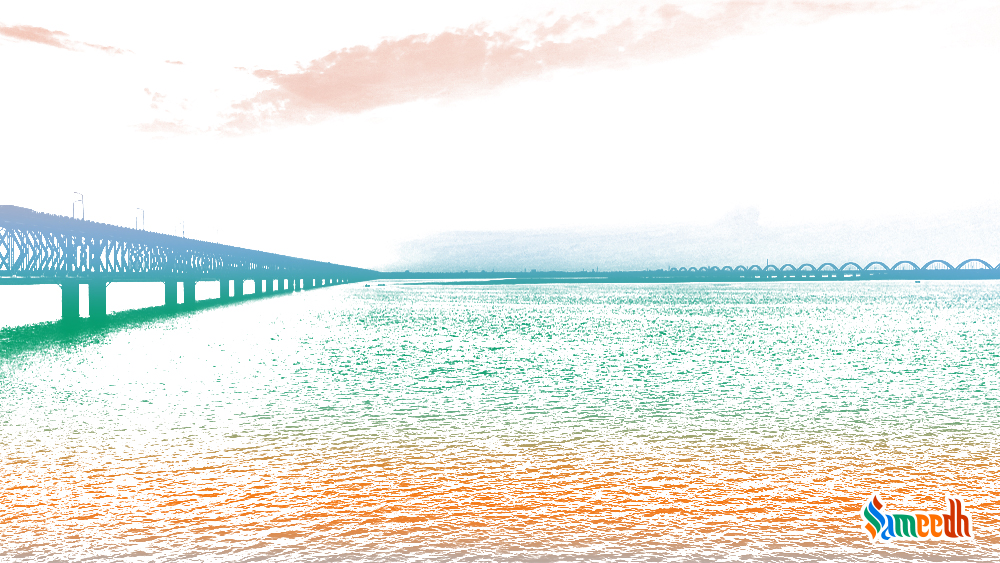The river is referred to as the ‘Dakshin Ganga’ meaning the ‘Ganga of south’. Ever wondered why the river has earned its sobriquet?

River Godavari flowing under The Godavari Bridge.
DESCRIPTION
The Godavari is India’s second longest river after the Ganga River and drains into the third largest basin in India, covering about 10% of India’s total geographical area. Measuring up to 312,812 sq.km., it forms one of the largest river basins in the Indian subcontinent, with only the Ganga and Indus rivers having a larger drainage basin.
LOCATION
The river springs forth at the Triambakeshwar near Nashik in Maharashtra and flows east for 1,465 kilometres passing through the states of Maharashtra, Telangana, Andhra Pradesh, Chhattisgarh and Odisha. The river ultimately empties into the Bay of Bengal through an extensive network of tributaries.
GODAVARI IN SCRIPTURES
The river has been revered in Hindu scriptures for many millennia and continues to harbour and nourish a rich cultural heritage. Before merging into the Bay of Bengal, Godavari had seven mouths in total and is thus considered sacred by Hindus. The seven branches by which it is traditionally supposed to have reached the sea are said to have been made by seven great rishis known as Sapta-Rishis. So, bathing in these mouths is considered an act of great religious efficacy by Hindus. These mouths are remembered by a Sanskrit sloka as follow:
|| tulyātreyī bharadvāja gautamī vṛddhagautamī ||
|| kauśikīca vaśiṣṭhaaca tathā sāgaraṃ gataḥ ||
The literal translation of the above shloka is that Godavari becomes Tulya, Atreyi, Bharadwaj, Gautami, Vriddhagautami, Kaushiki and Vasishta and then passes into sea.
SIGNIFICANCE IN HINDUISM
A legend has it that the sage Gautam lived in the Brahmagiri Hills at Triambakeshwar with his wife Ahilya. The couple lived the rest of their lives in the then village called Govuru, now known as Kovvur. Ahilya lived in a nearby place called Thagami (now Thogummi). The sage, as a reason for the practice of ‘annadan’, started cultivating rice crops and other crops. Lord Ganesh, on the wish of the munis, sent a miraculous cow ‘Mayadhenu’, which resembled a normal cow. It entered the sage’s abode and started spoiling the rice while he was meditating. Since cattle is sacred to Hindus and shall always be treated with respect, he put the Darbha grass on the cow. But, to his surprise, it fell dead. Seeing what happened before their eyes, the munis and their wives cried out, “We thought that Gautam maharishi is a righteous man, but he has killed a cow!”. The sage wished to atone for this grievous sin. Therefore, he went to Nashik and observed tapas to Lord Triambakeshwar (a manifestation of the god Shiv), and asked him to make the Ganges flow over the cow. Shiva was pleased with the sage and diverted the Ganges which washed away the cow and gave rise to the Godavari River in Nashik.
The river is sacred to Hindus and has several religious places on its banks that have been places of pilgrimage for thousands of years. Amongst the huge numbers of people who have bathed in her waters as a rite of cleansing are said to have been the deity Baladev 5000 years ago and the saint Chaitanya Mahaprabhu 500 years ago.
THE SAPTA SAGARA YATRA
In olden days a pilgrimage named as ‘Sapta Sagar Yatra’ was made by those desirous of offspring along the banks of the holy waters from the seven mouths. It starts with holy bathing at Tulyabhaga river at Chollangi village during On Amavasya day during Krishna Paksha of Pushya month as per Hindu calendar. That day is locally referred to as Chollangi Amavasya. That place where the river branch merges with sea is referred as Tulya Sagar Sangam. Secondly, they take bath in Coringa village in the Coringa river which is considered as Atreya branch of Godavari and the holy bathing place is called Atreya Sagar Sangam. After bathing at different banks of the other branches the pilgrimage ends by bathing near Narsapuram or Antarvedi.
THE SOBRIQUET OF DAKSHIN GANGA
As Gautam rishi did penance to Lord Triambakeshwar, and asked him to make the Ganges flow over the cow. Shiva diverted the Ganga which washed away the cow and gave rise to the Godavari River in Nashik. Even in terms of length, catchment area and discharge, the Godavari is the largest in peninsular India, and had been dubbed as the ‘Dakshin Ganga’ (Ganga of the South).
IN POPULAR CULTURE
One of the ships of the Indian Navy has been named INS Godavari after the river. Godavari is also the codename of some variants of AMD APU chips.
To know more about Hinduism, its Vedic belief system, vedic lifestyle practices, etc. or to replenish your requirements of vedic pooja samagri, or to learn vedic practice systems like yoga, pranayam, etc. please visit our website Sameedh.
